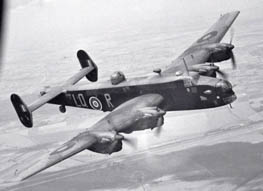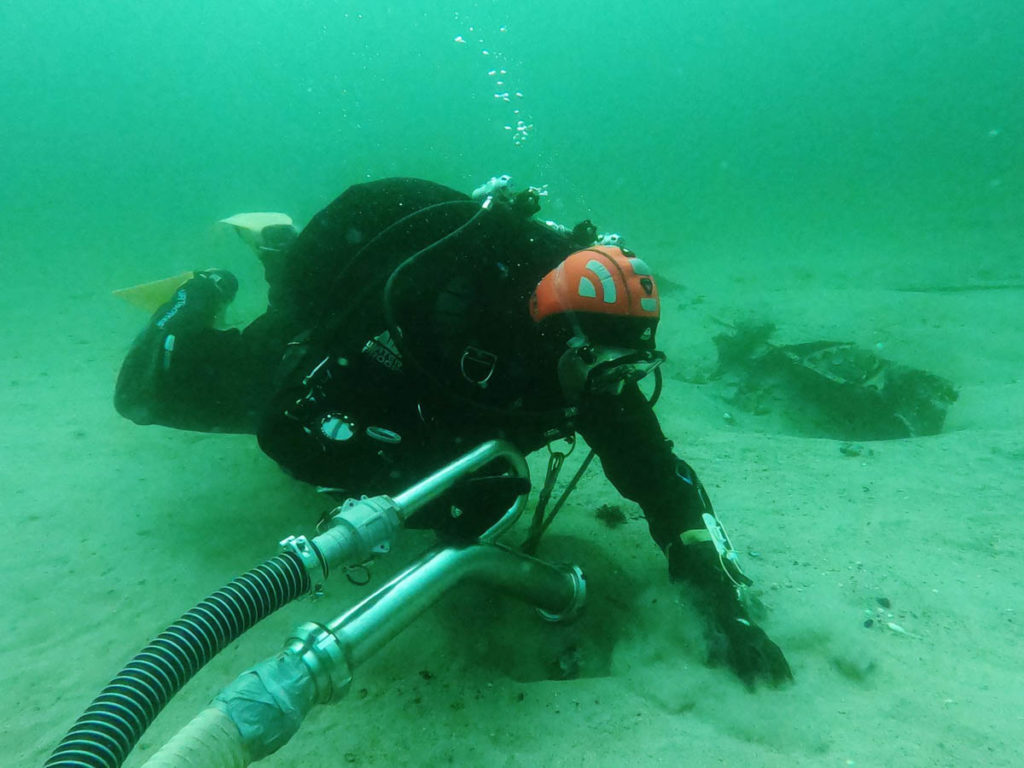Lasse, one of our Danish divers using SUE to uncover more flaps and ailerons of the Halifax.
Halifax 57 Rescue is an aircraft recovery group that is planning to recover RCAF Halifax HR871, with partners Swedish Coast and Sea Center and Havsresan of Sweden, from the Baltic Sea for the Bomber Command Museum of Canada in Nanton, Alberta.
Halifax HR871 was a B. Mk. II Series IA, one of 47 (HR837 – HR880) aircraft built by Handley Page’s Radlett Aerodrome facility in Hertfordshire. HR871 was powered by four Rolls Royce Merlin liquid-cooled V-12 piston engines producing 1,390 horsepower. Various versions of the Halifax served with RCAF squadrons until the end of the war.
The RAF Bomber Command dispatched a force of 740 aircraft on the night of August 2/3, 1943, consisting of 329 Avro Lancasters, 235 Handley Page Halifaxes, 105 Short Stirlings, 66 Vickers Wellingtons, and five de Havilland Mosquitos. Their “target for tonight” was the German port city of Hamburg. The joint British and American bombing campaign against Hamburg, dubbed “Operation Gomorrah,” began on July 24, 1943. The British bombed at night, while the Americans bombed during the day.
This would be the operation’s final night. The crews were met by a massive thunderstorm over Germany, and the severe weather forced many planes to return. Other crews continued on to their alternate targets. At least four aircraft, if not more, were destroyed by severe icing, lightning strikes, and bone-jarring turbulence. It was an expensive operation with little to show for it. Thirty aircraft were lost, including 13 Lancasters, ten Halifaxes, four Wellingtons, and three Stirlings, accounting for 4.1% of the total force sent out that night.

The HR871 encountered the aforementioned thunderstorm around 21,000 feet during the outbound leg to Hamburg. Ice began to accumulate on the Halifax’s control surfaces, causing it to become sluggish and difficult to control. It wouldn’t have stood a chance if they had to avoid night fighters or flak, so Pilot Sargent Phillips quickly decided to ditch the TIs – target Indicators. Lightning struck the forward section of the Halifax moments later. Both inner engines were destroyed, the radio was rendered inoperable, and several critical instruments failed to function. Phillips made the decision to turn the plane northward in the hope of reaching neutral Sweden. Phillips changed course to a southwesterly heading, taking the plane back out over the Baltic Sea. He trimmed the controls before issuing the command to bail out. They were close to Flyinge, Sweden’s largest and most well-known horse breeding station. The crew members fell into the dark sky one by one.
Phillips jumped at around 02:15 a.m. GMT, while the plane was at 3,000 feet. He slowly descended until he came to an abrupt halt in a farmer’s field near Esarp. He landed on top of an unsuspecting cow which died. After a while, he flagged down the driver of a milk truck and persuaded him to take him to Malmö, where he ended up in the hands of the police. The rest of the crew was rounded up and taken to Revingehed army barracks. They were subjected to the standard interrogation by air force intelligence officers.
The bomber flew on until it crashed into the Baltic Sea, fifteen kilometres off the Swedish coast, and sank in twenty metres of brackish (slightly salty) water. Since then, it has been inundated and covered in sand, though three engines and small portions of the aircraft remain visible above the sand on the seafloor.
When the interrogations were completed, the entire crew boarded a train bound for Falun, where they would be interned. During January 1944, the crew was repatriated to England in groups.
According to a report, Pilot Sargent Phillips lived his post war years in the East Riding of Yorkshire with his wife, Mabel. Valley of the Shadow of Death, a riveting book about wartime bombing operations in the spring and summer of 1943, was written by him. He was, as of 2015, the only remaining crew member still alive. As of this article, it is unknown when/if he has passed.






